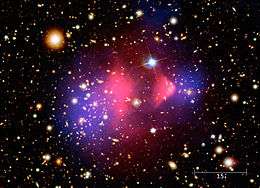Dark fluid
| Part of a series on | |||
| Physical cosmology | |||
|---|---|---|---|
 | |||
|
Early universe
|
|||
|
Components · Structure |
|||
| |||
In astronomy and cosmology, dark fluid is an alternative theory to both dark matter and dark energy and attempts to explain both phenomena in a single framework.[1][2]
Dark fluid proposes that dark matter and dark energy are not separate physical phenomena as previously thought, nor do they have separate origins, but that they are strongly linked together and can be considered as two facets of a same fluid. At galactic scales, the dark fluid behaves like dark matter, and at larger scales its behavior becomes similar to the dark energy one. Our current observations within the scales of the Earth and the Solar System are currently insufficient to explain the gravitational effects observed at these larger scales.
Overview
Two major conundrums have arisen in astrophysics and cosmology in recent times, both dealing with the laws of gravity. The first was the realization that there aren't enough visible stars or gas inside galaxies to account for their high rate of rotation. The theory of dark matter was created to explain this phenomenon. It theorizes that the galaxies are spinning as fast as they are because there is more matter in those galaxies (including our own Milky Way) than can be seen by counting the mass of stars and gas alone, and that this unseen (dark) matter is invisible because it doesn't interact with the electromagnetic force from which all forms of light comes, which we use to see things.
The second conundrum came from the observations of a very specific kind of supernova, known as a Type Ia supernova: when they were compared in distant vs. nearby galaxies, it was found that the distant supernova were fainter, and thus farther away than expected. This implied that the Universe was not only expanding, but accelerating its expansion. The theory of dark energy was created to explain this phenomenon.
In the traditional approach to modeling effects of gravity, general relativity is assumed to be valid at cosmological scales as well as in the Solar System, where its predictions have been more accurately tested. Not changing the rules of gravity, however, implies the presence of dark matter and dark energy in parts of the Universe where the curvature of the space-time manifold is far less than that in the Solar System. It is phenomenologically possible to alter the equations of gravity in regions of low space-time curvature such that the dynamics of the space-time causes what we assign to the presence of dark matter and dark energy.[3] Dark fluid hypothesizes that the dark fluid is a specific kind of fluid whose attractive and repulsive behaviors depend on the local energy density. In this theory, the dark fluid behaves like dark matter in the regions of space where the baryon density is high. The idea is that when the dark fluid is in the presence of matter, it slows down and coagulates around it; this then attracts more dark fluid to coagulate around it, thus amplifying the force of gravity near it. This description is similar to theories of dark matter. The effect is always present, but only becomes noticeable in the presence of a really large mass such as a galaxy. If this effect sounds very much like a description of dark matter, then that's not a coincidence, as a special case of the equations of dark fluid reproduces dark matter.
On the other extreme, in places where there is relatively little matter, as in the voids between galactic superclusters, the theory of dark fluid predicts that the dark fluid relaxes and get a negative pressure. Thus dark fluid therefore becomes a repulsive force, with an effect similar to that of dark energy.
Dark fluid goes beyond dark matter and dark energy in that it predicts a continuous range of attractive and repulsive qualities under various matter density cases. Indeed, special cases of various other gravitational theories are reproduced by dark fluid, e.g. inflation, quintessence, k-essence, f(R), Generalized Einstein-Aether f(K), MOND, TeVeS, BSTV, etc. The dark fluid model also suggests new models such as a certain f(K+R) model, which suggests interesting corrections to MOND that depend on redshift and density.
Simplifying assumptions
Dark fluid theory is not treated like a standard fluid mechanics model, because many of the fluid mechanics equations are too difficult to solve completely. A formalized fluid mechanical approach, like the generalized Chaplygin gas model, would be an ideal method for modeling this theory, but it requires too many observational data points to work properly, and there are not enough such data points available to cosmologists yet. So a simplification step was undertaken by modeling the theory through scalar field models instead, as is done in other alternative approaches to dark energy and dark matter.[2][4]
References
- ↑ Alexandre Arbey (2005) "Is it possible to consider Dark Energy and Dark Matter as a same and unique Dark Fluid? http://arxiv.org/abs/astro-ph/0506732"
- 1 2 Alexandre Arbey (2006) "Dark Fluid: a complex scalar field to unify dark energy and dark matter http://arxiv.org/abs/astro-ph/0601274"
- ↑ Exirifard, Q. (2010). "Phenomenological covariant approach to gravity". General Relativity and Gravitation. 43: 93–106. arXiv:0808.1962
 . Bibcode:2011GReGr..43...93E. doi:10.1007/s10714-010-1073-6.
. Bibcode:2011GReGr..43...93E. doi:10.1007/s10714-010-1073-6. - ↑ Arbey, A.; Mahmoudi, F. (2007). "One-loop quantum corrections to cosmological scalar field potentials". Physical Review D. 75. doi:10.1103/PhysRevD.75.063513.
External links
- Arbey, A. (2008). "Cosmological constraints on unifying Dark Fluid models". The Open Astronomy Journal. 1: 27–38. doi:10.2174/1874381100801010027.
- Zong-Kuan Guo, Yuan-Zhong Zhang, Cosmology with a Variable Chaplygin Gas" (2005).
- Anaelle Halle, HongSheng Zhao, Baojiu Li Perturbations in a non-uniform dark energy fluid: equations reveal effects of modified gravity and dark matter" (2008)
